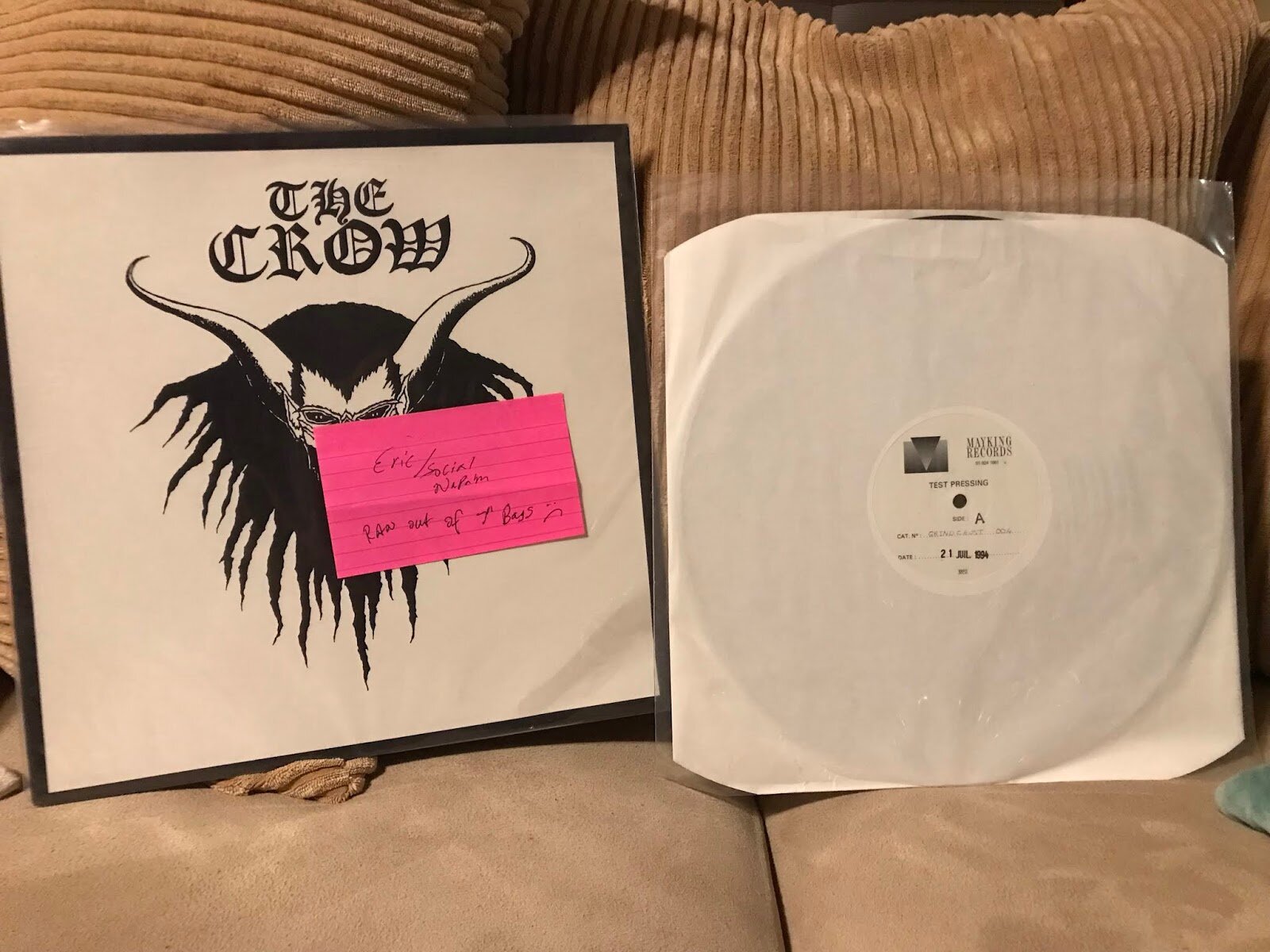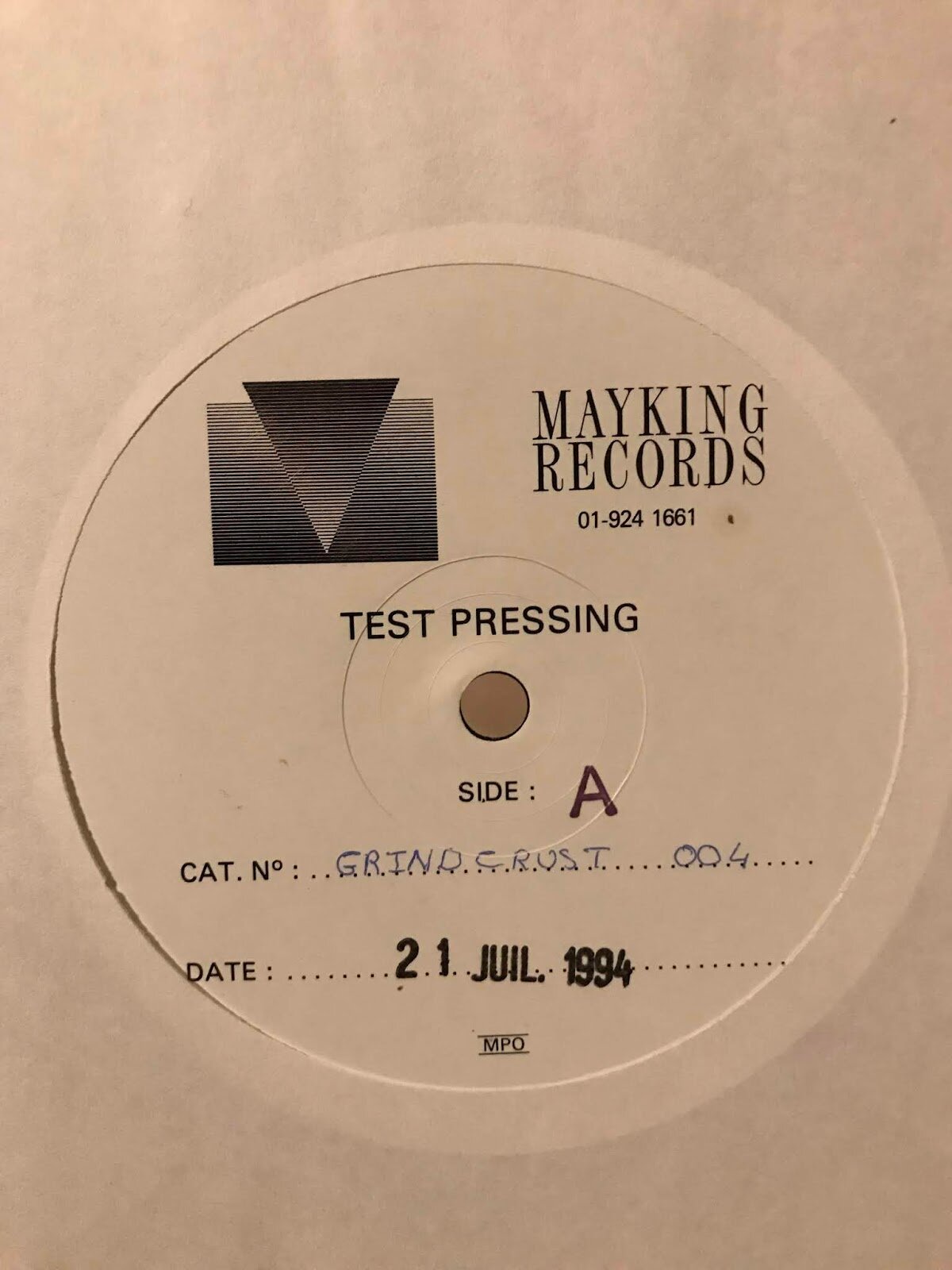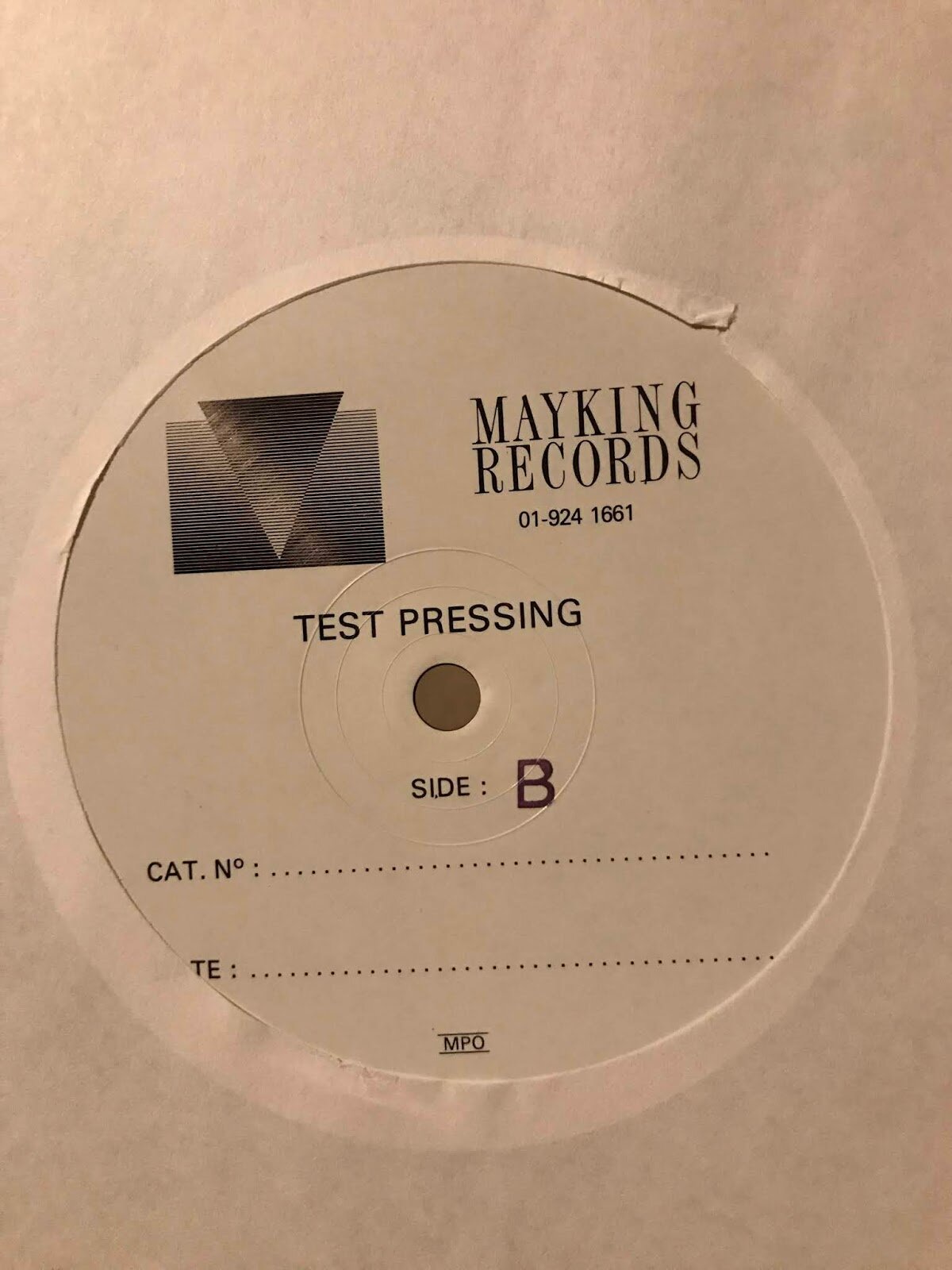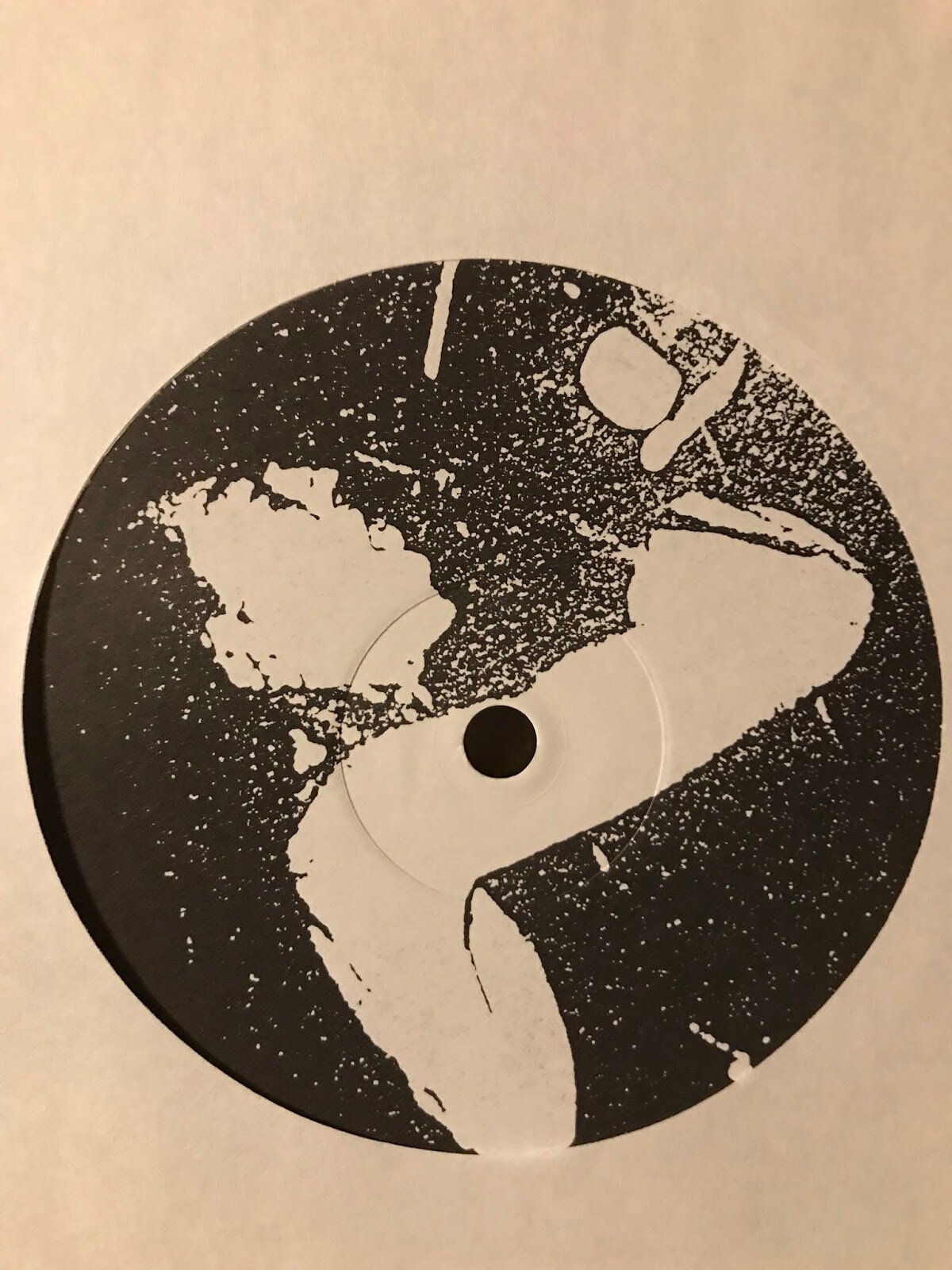End of an era: How a small DIY label resurfaced Crow's lost sessions on British soil
The Crow self-titled LP on Grind//Crust Records, 1995
Article written and researched by April.
Photo of Takacho (SDS), Kan (Asbestos) and Crow (The Crow) taken in 1993. From the collection of Takacho (SDS) and used with permission.
All other photos of ephemera from the private collections of April, Tom at General Speech, and Negative Insight.
Long before Japanese bands like Disclose and Framtid carved their images into D-beat's metaphorical Mount Rushmore, mid-'80s releases from Crow, Disarray, and Sodom lead Japan's first distinct Discore wave. Despite a sizable discography and roughly two non-consecutive decades active, relatively little is known abroad about the early history of Crow, Osaka's classic Discharge evangelists. Among their arcane history, the band's posthumous second EP, commonly known as "The Crow," is perhaps their most mysterious outing. Released in 1995 after the band's dissolution, but before the band reformed in Tokyo in the mid to late '90s, the 12" EP is the misunderstood middle child of the Crow discography. When asked why there was an entire year between the record's two recording sessions, Crow (the vocalist and namesake founder of the band) attributed it to "civil war." Much like Discharge's "Grave New World," which partially inspired it, the EP represents the final recordings of the band's early history and a snapshot of a band on the brink of implosion.
Prior to founding the band in (approximately) 1983, Crow's namesake vocalist began his music career by creating noise music (inspired by such artists as Diamanda Galás, Tamia Valmont, and Patty Waters). Two years later, Crow self-released their first record, the Discharge-inspired "Who Killed Dove?" EP, in late 1985. Incorporating other bits of UK hardcore influence, the EP's iconic cover art was directly inspired by the back cover of the "Punk And Disorderly III: The Final Solution" compilation. Another two years later, their first album and now impossibly rare collector's item, "Last Chaos," was self-released with a scant press run of approximately 200 copies.
Crow with SOB circa 1985
While these first two records enjoy that patented raw recording that has ingratiated countless Japanese flexis into the hearts and minds of collectors everywhere, their followup contributions to "The Eye Of Thrash Guerrilla" compilation featured a more professional recording and beefier sound. Released on Selfish Records in late 1988, the recordings saw the band shifting towards the metal tinge that defined the band's later Tokyo era. Whereas the first two records were the product of the vocalist's singular D-beat vision, select compilation tracks were written by the other members of Crow. Tensions with the rest of the group, who were influenced by recent USHC, are most easily recognizable in the idiosyncratic songs "Disgust" (written by guitarist Mitsunobu) and "I'm Looking Out Over" (written by bassist Taku). If you listen to the latter song on loop, you may start experiencing hallucinations that it's a crust band covering an early Dischord Records track.
The band didn't last much longer after the compilation's release. The penultimate performance, and final with the band's original lineup, was held at Kyoto University's Western Auditorium following the death of Emperor Hirohito in January of 1989. The Cry Day festival, a large three day protest against censorship taboos, was the wailing death knell for Japan's Shōwa era. The band played at the invitation of members of The Continental Kids, and unsold copies of "Who Killed Dove" were signed and given out to the audience. Later returning to his noise roots, the ultimate performance under the Crow monicker was an improvised set at Namba Bears with Ikuo Taketani (Hanatarashi, Boredoms), Atsushi Tsuyama (Omoide Hatoba, Nankai Hawkwind), and venue owner Seiichi Yamamoto (Boredoms, Omoide Hatoba) as his backing band.
When the band was no more, two sets of unreleased songs were left over. The first group of songs, which were created independently, later became the basis of 1998's "Death Of Nuclear Arms" EP. The other set of songs, recorded in 1988 and 1989 with the original lineup, became "The Crow" 12". These five songs, released in 1995 on the UK record label Grind//Crust, were the posthumous conclusion to Crow's Osaka era. Continuing where "The Eye Of Thrash Guerrilla" left off, the band further embraced a fuller, metallic crust sound. The last three tracks are re-recordings of songs that previously appeared in much rawer form on "Last Chaos." The first of which, "Hiroshima Nagasaki," is given an extended, pummeling introduction. The other two, "Is This Fiction?" and "Storms Of Despair," have their arrangements unchanged, but receive dual, layered vocals.
But these songs are not what made the record so infamous. If you only know one thing about this record, it's probably the incongruous, high-pitched vocals that open the record on the paradoxically-titled "The End." In a 2009 interview with El Zine, Crow's vocalist recalls that he was attempting to imitate Cal's falsetto vocals on 1986's "Grave New World" LP. This revelation should come as no surprise to anyone with at least one functioning eardrum and a brain. Crow was once again on the bleeding edge of Discharge worship, although he was much further ahead of the curve on "Grave New World" appreciation. At nearly six minutes, "The End" was also the longest song of Crow's Osaka era and about triple the average length of the band's preceding material. Conversely, the more traditional D-beat song that follows, "Born To Die," is the shortest song of their Osaka era and earns solid marks in Discharge's "less is more" school of songwriting theory.
Adding to the general mystique and impenetrability of "The Crow" and the band's Osaka era, the band members are credited differently across different releases. Guitarist Mitsunobu Kawaminami, who went by "Dada" on the first two Crow records, is credited as "Nobuo" on "Eye Of Thrash Guerrilla" and "Kawaminami" on "The Crow." Bassist Taku Ito and drummer Masa Sato (previously "Luchi"), are also credited by first name on the compilation and surname on "The Crow." Despite conflict, the lineup remained consistent from the band's second ever show (the first featured a guitarist named Hirano) up until the Kyoto University performance.
But how did the record come to be released on a small DIY record label on the other side of the world? Shortly after the band's dissolution, Crow's namesake leader was lured to Tokyo by former members of Asbestos in need of a vocalist for a new project. That band, Grave New World, was essential to the "The Crow" EP's ultimate release. For one, the stark, horned illustration that adorns the cover was a product of Grave New World's short existence, having first appeared on flyer artwork for the band. But more importantly, his time in the band led to meeting and befriending SDS vocalist and Japan's resident punk Anglophile—Takacho. Having only crossed paths once prior at a Crow show in Nagoya, the two became friends when SDS and Grave New World began playing shows together in the early '90s. An astute collector may notice that under his full name, Kenichi Takahashi, Takacho enjoys the distinction of being the only person Crow gives special thanks to on "The Crow" and the 1994 Overthrow Records reissue of "Last Chaos."
Takacho (SDS), Kan (Asbestos) and Crow (The Crow) enjoying the high life 1993
It was through Takacho that Ben Moody, the owner of the bedroom DIY label Grind//Crust, heard of the existence of unreleased Crow material and decided to release it. As Moody recalled in 2011, prior to his untimely passing:
"I was at an SOB gig in Oxford. A man there was selling records [Mike Foster of MCR UK], all of them Japanese. I bought four, as I recall, one whereof was SDS's "Never Arise" 7". So impressed was I by SDS that I wrote to them. Over the following months, Kenichi (the singer) and I exchanged numerous letters. He mentioned the second Crow EP in one of his letters. It didn't cross my mind that it was unusual for a European label to release a Japanese group's records (In Your Face released a Rose Rose album, and Rise Above released a few SOB records, but I can't think of many others)."
Test pressings were made in 1994 and the record was finally released (in another unfortunately modest press run of 500 copies) a year later. Perhaps it's a testament to the "network of friends" philosophy of punk that fellow Osakans, SOB, played an inadvertent but crucial role in the record's obscure history. As Moody concluded:
"[Takacho's] idea it was to release the Crow EP; he'd learnt from Crow (the bloke in The Crow who calls himself Crow) that they (The Crow) had recorded a second EP after "Who Killed Dove" and the "Eye of the Thrash Guerilla" tracks, but had disbanded before it was released. Kenichi (from SDS) asked whether I'd be willing, and the adage about a fool and his money comes again to mind. I might've sold twice as many and perhaps made some money; failing that, I should've kept some and sold them now at inflated prices. Hindsight is a sour dish."
Grave New World flyer for 1992/1993 gigs
"I suppose the lesson to be learnt from my releasing the Crow 12" is that one is introduced to new ideas through people (if I hadn't approached the man at the SOB gig, I shouldn't have come across [SDS]; if I hadn't written to them, I shouldn't have heard about the Crow EP; if I hadn't been speaking to Scruff Lewty [of Hellbastard], the idea of releasing records wouldn't have been put into my head). Somebody told me, once upon a time, that communicating itself was a form of rebellion because, for the most part, folk don't and that's why the system goes unchallenged. It seems too simple to be true, but maybe he was right."
In the decades since Crow first formed, D-beat has become its own art form--studied, practiced, and iterated across the globe. Disaster's "War Cry," for example, is like a master forgery, the product of exact study and imitation. However, earlier waves were unable to imitate Discharge so holistically. Early Crow material, in contrast to Disaster, is more like a police sketch, recognizable but approximate. This may sound like a criticism, but it's the discrepancies that have helped make Crow's early material timeless.
Photos below include cover and test pressing labels and full pressing labels as well as rare green insert version (standard version is on white paper):










